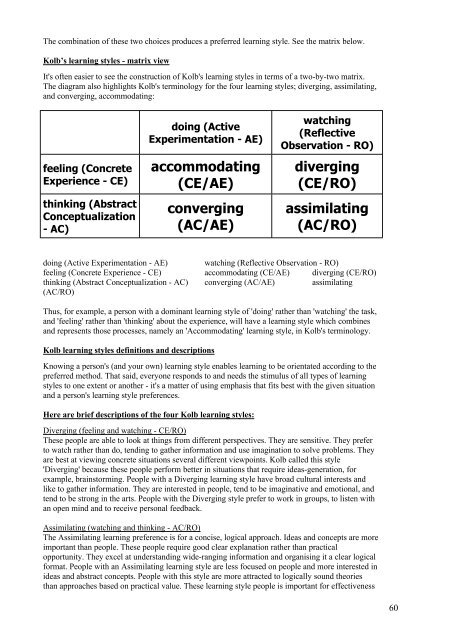How to Perform On-the-job Training - Dean Amory
According to The Encyclopedia of Business, ©2000 Gale Cengage, On-the-job training is by far the predominant form of job training. Studies also indicate that it is the most effective form of job training. Yet, it also represents a significant investment considering that roughly 30% of a new worker's time is spent in on-the-job training during the first 90 days of employment, that productivity of experienced workers assigned to train new workers may decrease during the training period, and that new workers may make expensive mistakes. Both companies and workers therefore profit largely from the presence of simple, but complete trainee and trainer guides that allow for executing OJT in a structured way. “How to perform on-the-job training”, has the information, techniques and tips that will allow you to implement a professional OJT training program. The book also includes all the tools, documents and checklists necessary for setting up a qualitative and efficient skills training program for OJT coaches
According to The Encyclopedia of Business, ©2000 Gale Cengage, On-the-job training is by far the predominant form of job training. Studies also indicate that it is the most effective form of job training. Yet, it also represents a significant investment considering that roughly 30% of a new worker's time is spent in on-the-job training during the first 90 days of employment, that productivity of experienced workers assigned to train new workers may decrease during the training period, and that new workers may make expensive mistakes.
Both companies and workers therefore profit largely from the presence of simple, but complete trainee and trainer guides that allow for executing OJT in a structured way.
“How to perform on-the-job training”, has the information, techniques and tips that will allow you to implement a professional OJT training program. The book also includes all the tools, documents and checklists necessary for setting up a qualitative and efficient skills training program for OJT coaches
Create successful ePaper yourself
Turn your PDF publications into a flip-book with our unique Google optimized e-Paper software.
The combination of <strong>the</strong>se two choices produces a preferred learning style. See <strong>the</strong> matrix below.<br />
Kolb’s learning styles - matrix view<br />
It's often easier <strong>to</strong> see <strong>the</strong> construction of Kolb's learning styles in terms of a two-by-two matrix.<br />
The diagram also highlights Kolb's terminology for <strong>the</strong> four learning styles; diverging, assimilating,<br />
and converging, accommodating:<br />
feeling (Concrete<br />
Experience - CE)<br />
thinking (Abstract<br />
Conceptualization<br />
- AC)<br />
doing (Active<br />
Experimentation - AE)<br />
accommodating<br />
(CE/AE)<br />
converging<br />
(AC/AE)<br />
watching<br />
(Reflective<br />
Observation - RO)<br />
diverging<br />
(CE/RO)<br />
assimilating<br />
(AC/RO)<br />
doing (Active Experimentation - AE) watching (Reflective Observation - RO)<br />
feeling (Concrete Experience - CE) accommodating (CE/AE) diverging (CE/RO)<br />
thinking (Abstract Conceptualization - AC) converging (AC/AE) assimilating<br />
(AC/RO)<br />
Thus, for example, a person with a dominant learning style of 'doing' ra<strong>the</strong>r than 'watching' <strong>the</strong> task,<br />
and 'feeling' ra<strong>the</strong>r than 'thinking' about <strong>the</strong> experience, will have a learning style which combines<br />
and represents those processes, namely an 'Accommodating' learning style, in Kolb's terminology.<br />
Kolb learning styles definitions and descriptions<br />
Knowing a person's (and your own) learning style enables learning <strong>to</strong> be orientated according <strong>to</strong> <strong>the</strong><br />
preferred method. That said, everyone responds <strong>to</strong> and needs <strong>the</strong> stimulus of all types of learning<br />
styles <strong>to</strong> one extent or ano<strong>the</strong>r - it's a matter of using emphasis that fits best with <strong>the</strong> given situation<br />
and a person's learning style preferences.<br />
Here are brief descriptions of <strong>the</strong> four Kolb learning styles:<br />
Diverging (feeling and watching - CE/RO)<br />
These people are able <strong>to</strong> look at things from different perspectives. They are sensitive. They prefer<br />
<strong>to</strong> watch ra<strong>the</strong>r than do, tending <strong>to</strong> ga<strong>the</strong>r information and use imagination <strong>to</strong> solve problems. They<br />
are best at viewing concrete situations several different viewpoints. Kolb called this style<br />
'Diverging' because <strong>the</strong>se people perform better in situations that require ideas-generation, for<br />
example, brains<strong>to</strong>rming. People with a Diverging learning style have broad cultural interests and<br />
like <strong>to</strong> ga<strong>the</strong>r information. They are interested in people, tend <strong>to</strong> be imaginative and emotional, and<br />
tend <strong>to</strong> be strong in <strong>the</strong> arts. People with <strong>the</strong> Diverging style prefer <strong>to</strong> work in groups, <strong>to</strong> listen with<br />
an open mind and <strong>to</strong> receive personal feedback.<br />
Assimilating (watching and thinking - AC/RO)<br />
The Assimilating learning preference is for a concise, logical approach. Ideas and concepts are more<br />
important than people. These people require good clear explanation ra<strong>the</strong>r than practical<br />
opportunity. They excel at understanding wide-ranging information and organising it a clear logical<br />
format. People with an Assimilating learning style are less focused on people and more interested in<br />
ideas and abstract concepts. People with this style are more attracted <strong>to</strong> logically sound <strong>the</strong>ories<br />
than approaches based on practical value. These learning style people is important for effectiveness<br />
60


















